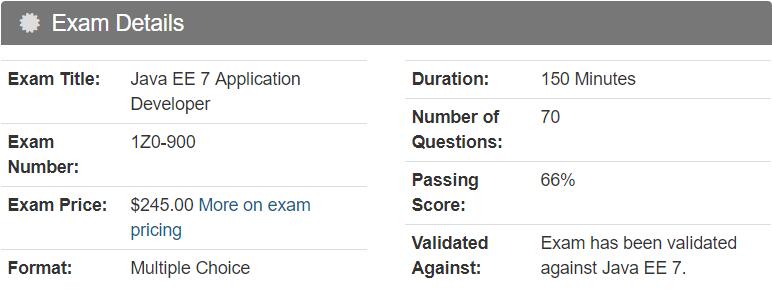Oracle 1Z0-900- Java EE 7 Application Developer
El examen 1Z0-900 Java EE 7 Application Developer es una prueba de certificación de Oracle, si está buscando ayuda con su examen de certificación 1Z0-900, Killtest es una plataforma definitiva para usted. Puede obtener la última prueba práctica de Oracle 1Z0-900 Preguntas de Killtest para estudiar y podemos garantizarle que pase el 100% de su examen de certificación Oracle 1Z0-900 con éxito.
Descripción general del examen 1Z0-900 – Desarrollador de aplicaciones Java EE 7

El examen Oracle Java EE 7 Application Developer valida la capacidad de programación para desarrollar e implementar aplicaciones utilizando Java Platform, Enterprise Edition 7. Está dirigido a desarrolladores, arquitectos e ingenieros de software Java Front-End y Back-end de nivel intermedio a avanzado. experiencia en el uso de la tecnología Java EE 7 para crear interfaces de usuario basadas en la web utilizando JavaScript junto con JSP, JSF, servlets y manejar la lógica empresarial.
Temas del examen Oracle 1Z0-900 cubiertos en Java EE 7 Application Developer
Understand Java EE Architecture
Implement Business Logic by Using EJBs
Implement SOAP Services by Using JAX-WS and JAXB APIs
Create Java Web Applications using JSPs
Create Java Applications using WebSockets
Secure Java EE 7 Applications
Use Concurrency API in Java EE 7 Applications
Manage Persistence using JPA Entities and BeanValidation
Use Java Message Service API
Create Java Web Applications using Servlets
Implement REST Services using JAX-RS API
Develop Web Applications using JSFs
Use CDI Beans
Use Batch API in Java EE 7 Applications
Descargar Oracle 1Z0-900 Preguntas de prueba de práctica
1.You need to develop a chat application, which allows the display of emoticons and images together with text messages.
How should you configure a WebSocket endpoints to receive both text and binary messages?
A. Create two @onMessagemethods in the same endpoint with appropriate parameter types.
B. Define the @onMessage methods in your endpoint with Object as parameter and check the actual type in your code.
C. You can achieve this only by creating separate WebSocket endpoints for each message type.
D. Create two @onMessagemethods, each with appropriate decoder attribute in the same endpoint.
Answer: D
2.Which two capabilities are provided by the Java Authentication and Authorization Services (JAAS) API? (Choose two.)
A. protecting data from unauthorized viewing by using encryption
B. verifying that a user is allowed to perform an action
C. ensuring that data is not modified in transit
D. verifying identity claims from users
Answer: BC
3.Which interface should you implement if you want to be alerted to the lifecycle events surrounding your task being executed by a ManagedExecutorService?
A. the RunnableInterface
B. the ManagedExecutorTaskinterface
C. the TaskEventListenerinterface
D. the ManagedTaskListenerinterface
Answer: D
4.What is true about Message-Driven Beans (MDBs)?
A. MDBs can participate in transactions.
B. MDBs are invoked synchronously.
C. Each MDBs can process messages only from a single client.
D. MDBs retain data caches between client calls.
Answer: A
5.You have been asked to implement internationalization in your JSF web application. Where do you configure the supported locales?
A. in the <f:view>tag of the Facelet page
B. in the web.xmlfile
C. in the faces-config.xml file
D. in the src folder
Answer: A
6.Java EE’s support for WS-Security includes handling which two types of security credentials? (Choose two.)
A. X.509 certificates
B. SAML tokens
C. OAuth Bearer tokens
D. Two-factor authentication tokens
Answer: AB
- "Passnow.mx" published in the article only to convey information, and is not endorsed or opposed of view.
- If the content had a negative impact or loss caused to you, do not assume any responsibility.
- Covering copyright issues, please contact us.

